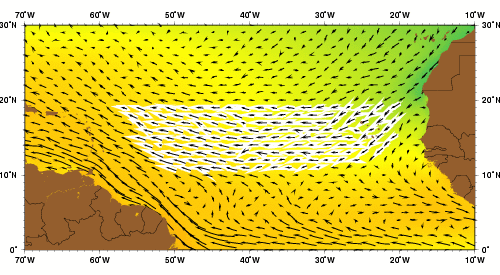
| ||
| The North Equatorial Current (NEC) as represented by the Mariano Global Surface Velocity Analysis (MGSVA). The NEC is the broad westward flow that is the southern component of the N. Atlantic subtropical gyre. It is fed by the Canary Current and its waters eventually end up in the Gulf Stream system, either via the Antilles current or through the Caribbean via the Guiana current. Click here for example plots of seasonal averages. | ||
The NEC found in the North Atlantic from about 7°N to about 20°N (see figure1; Schott et al, 2002). Fortified by the Atlantic trade wind belt, the NEC is a broad westward flowing current that forms the southern limb of the North Atlantic subtropical gyre (Bourles et. al. 1999b). The current originates from the northwestern coast of Africa, where it is fed mainly by the cooler waters flowing from the northeast Atlantic. As the NEC travels across the open ocean, it is joined by waters originating south of the equator thus entraining waters from the Southern Atlantic into the Northern Atlantic. The details of these various pathways of cross-equatorial water exchange in the open-ocean remain unclear, in part because of the weak, meandering North Equatorial Counter Current (NECC), which lies south of the NEC. It is understood that the complex seasonal retroflection and recirculation current systems that straddle the equatorial region and the strong western boundary currents along the American shelf also play an important role in water-mass exchange with the NEC, however exactly how is not well understood (Arnault et al, 1999; Schott et al. 2002). Estimates by Onken (1994) suggest that wind-stress causes about 12 Sv of cross-equatorial transport to the north.
When the NEC approaches the shelf region of the Americas, its interaction with bottom topography and accompanying western boundary currents produce a complicated, seasonally variable flow regime, both laterally and vertically, that is still the source of continued investigations. The coastal and near-coastal region along the east coast of South America is, as described by Arnault and others (1999), is a spawning ground for meso-scale eddy activity, which compounds the difficulties in discerning the general flow regimes. However, most authors concede that the overall flow is to the northwest to supply the Guiana and Caribbean Currents (Bourles, et. al., 1999a; Arnault et. al. 1999; Bourles et al, 1999a & 1999b). In the open ocean, the NEC, a broad current, is generally identifiable north of 10°N and has a westward mean velocity between 10-15 cm s-1 (Richardson and Walsh, 1986). Its peak velocity values of 15 cm s-1 are prevalent in boreal summer (July/August), with a weakening to 10-12 cm s-1 during spring and fall (Arnault, 1987). Most of the NEC waters flow northwest and feed the Guiana Current and the Caribbean Current (Bourles et al, 1999a), some of the water is retroflected cyclonically to join the eastward-flowing NECC. According to Wilson and others (1994), some of the NEC water is also deflected downward, supplying approximately 12 Sv to the North Equatorial Undercurrent (NEUC), which lies at intermediate depths between 100m and 300m.
The boundary between the NEC and the Guiana current exhibits a large amount of seasonal variation. Latitudinal shifts in this boundary cause the currents at 2°N to shift direction four times a year between 0°-10°W. From approximately January to February and then again between August and October flows are eastward. Westward flows prevail from November to December and again from March through April. (Richardson and Walsh, 1986).
The annual mean transport is 8.5 Sv with the lowest transports occurring in late winter and in spring (Bayev and Polonskiy, 1991). The annual transport variation in the NEC is 2.3 Sv and the semiannual variation in the NEC is 1.1 Sv, in addition to a large residual variance of 1.3 Sv. (Bayev and Polonskiy, 1991). The maximum variation in transport has a magnitude of 1.5 Sv and occurs between June and January, with a mean transport of about 10 Sv during this period (Bayev and Polonskiy, 1991). Seasonal variation of the North Equatorial Current coincides with than of the Canary Current attaining its maximum during summer (Mittelstaedt, 1991, Stramma and Seidler, 1988).
In the late summer and early fall, temperatures range between 30° and 32°C and in the winter range between 24° and 28°C. Salinities range widely between the summer and winter months. According to the PIRATA (Pilot Research Moored Array in the Tropical Atlantic) program data that has been gathered since 1998, salinities at 38°W and 12°N typically range between 35.2 in the winter, and increase in the summer, when evaporation increases, to about 36.4. Subsurface values, from about 20 to 40 meters, have been recorded to be as low as low as 34.4 during the winter.